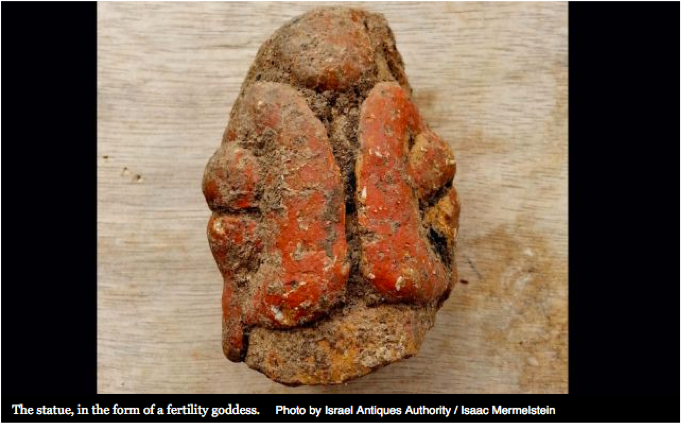"New archaeological finds challenge ideas of prehistoric Israel Neolithic fertility goddess figure found in rescue dig could change thinking about ancient cultures."

By Nir Hasson | May 7, 2015 | 4:52 AM | Haaretz Article | http://bit.ly/1FZmw24 | Thank you K.
“A small statue most likely used as a ritual object could change the view of archaeologists about the beginnings of the period of human settlement in the Middle East. The statue, in the form of a fertility goddess, was found in a rescue dig being conducted before the Mekorot water company lays a new pipeline close to Moshav Beit Hilkia, near Gedera in south-central Israel.
Remains from three prehistoric periods were found in the dig. The oldest have been dated to about 7,000 years ago. during the Pottery Neolithic period. Archaeologists from the Israel Antiquities Authority also found a fired ceramic clay figurine of a full-figured woman.
The discovery brings the number of sites at which similar figures from the period have been found to nine, mostly around Sha’ar Hagolan. Of the 163 such figurines found so far, two were found elsewhere - one in Lod and the other at Horvat Ptora, a site near Kiryat Gat and the one found now as said, in Revadim, near Gedera.
These figures are mostly attributed to what is known as the Yarmukian culture that flourished mostly in northern Israel about 7,500 years ago. This is a different culture than has been found in digs close to Beit Hilkia, such as at Revadim, known as “Jericho 9.”
The differences between the cultures are best seen in the pottery they made. If in the past, archaeologists thought Jericho 9 replaced the Yarmukian culture, the more accepted theory today is that the two cultures existed at the same time, but in different areas: the Yarmukian in the north and Jericho 9 in the south.
The discovery of the figurines – clearly Yarmukian – accompanied by the other two found in the region raises the question of the relationship between the two cultures.
“I think that in the end this is one culture with differences in the way pottery is made,” said Dr. Edwin van den Brink, who was in charge of the excavation along with Yitzhak Mermelstein. It is a big deal for the archaeologists, he said – but for the people who lived back then the differences were not so important. “It seems they had a single system of beliefs.”
“The question is whether the figurines represent a single ritual world in which there is an image with a bountiful chest, wide hips and maybe pregnancy,” said Marmelstein. “The most important question is whether the figures were made in the south or brought from the north.”
The archaeologists are now planning to conduct chemical tests of the statue to determine the source of the clay – whether it is from the north or south of Israel.”